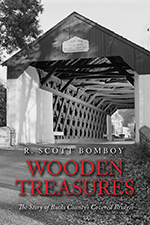Editor’s Note: World War II was taking its toll on Perkasie’s domestic economy during 1944, a year that also saw the most fatalities for local servicemen during the global conflict.
The news in Perkasie during 1944 would be dominated by the deaths of 13 local young men in service of their country and the sense that World War II was about to end.
To be sure, labor shortages, rationing, and an upcoming presidential election were big news, too, in a small town. But the price of freedom was steep, and the nation would keep paying that price for another 20 months.

The U.S. Gauge played a key defense role
PFC Kenneth Maurer, 19, of Blooming Glen was the first causality of 1944 reported to a war-weary public. His mother received the telegram on January 2, 1944, that her son died in action in Italy. Then on February 3, 1944, Lieutenant Charles Gemmell was reported missing in action after the plane he was piloting was shot down over Germany. (Gemmell was captured by the Germans and released a year later.)
David Phillip Orr, a veteran of both World Wars and a former Perkasie resident, died when his destroyer was sunk in action in the Pacific. Orr had enlisted in the Canadian Army during World War I and survived a gas attack on the front lines during that war. Orr had sent a letter to his family on the same day he was killed. Two of Orr’s brothers were also serving in the Pacific Theater. A week later, news came that PFC Earl Kramer was killed in action in Italy.
In late March the area’s biggest employer, the United States Gauge Company, announced it had merged with a New York firm. By 1944, the Gauge was producing more than 50 percent of gauges used in the American war effort, and the deal boosted the financial health of the Sellersville firm.

WAVES in training in California
The military also stepped up its recruitment of women, who weren’t subject to the draft, to programs like the WAACS, the WAVES, the WASPs, and as nurses. Ensign Marie Bader, on leave from Navy WAVE duty at the Brooklyn Ship Yard, spoke in Sellersville about the rigors of her training at Smith College. Officer-level candidates studied history and the law; all WAVES received self-defense training but they were not allowed in combat settings.
On April 27, Sergeant Richard Hager was reported as missing in action and when his plane didn’t return after it attacked Truk, the Japanese Navy’s largest fuel depot outside of Japan.

D-Day 1944
After a somber Memorial Day ceremony, news came early on June 6, 1944 about the Allied invasion of Western Europe at Normandy. There were no public celebrations; instead, people reported to work while Borough residents listened to updates on the radio. At 7:30 p.m., joint prayer services were held at the community’s churches and also prayers were given before each movie shown at the Plaza Theater.
Later that month, Corporal Robert Horning of Eight Street in Perkasie told the News-Herald about how he survived capture by the Germans after he was wounded on a battlefield in North Africa. When Nazi soldiers found him and asked if he could walk after receiving wounds in the arm and leg, Horning shrugged his soldiers and then replied in apparently very good German. After the impressed Nazis said they would return for him and left, Horning got up and walked back to the American lines.

Hank Eisenhart
Also in June 1944, the News-Herald did miss a news scoop that would have thrilled baseball-crazy Perkasie: local sports star Jacob Henry “Hank” Eisenhart from Fourth Street became the first Perkasie-born resident to appear in the major leagues. Eisenhart, a left-handed pitcher, was on a 30-day contract with the Reds and got the final out in their 18-0 loss to the Cardinals on June 10. He replaced 15-year-old Joe Nuxhall, the youngest player in major league history, who struggled in his debut.
By early August 1944, the military confirmed that Richard Hager had died in action, and PFC John H. Forys had been killed in France. Also, Lieutenant Alexander Evanko of Sellersville, a P-38 fighter pilot, was missing in action in Europe, and Corporal John G. Hedrick died during the Allied invasion of France. The start of the school year at Sell-Perk High School was tempered by the news that Stanley Magargal, who had left school in February at the age of 17 to enlist in the Navy, had been killed in action in the English Channel when his ship struck a mine.
In October 1944, the News-Herald announced it could no longer send free copies of its 12-page newspaper to servicemen and servicewomen because of government restrictions on newsprint. But on October 19, 1944, Perkasie’s Community Service Group, a volunteer organization that supported the military by sending letters and a dollar bill to soldiers and sailors each month, said it would deliver lightweight two-page version of the News-Herald to servicemen and servicewomen. The Perkasie community financially supported the Community Service Group through donations.
That same day, the newspaper reported that Sergeant Daniel Pompeii had been killed in action in France. Pompeii was wounded at Anzio in Italy and had returned to the front. During October, William D. Fox, an Army tank crew member, was reported as missing in action in Germany. Also in October, Gunners Mate Harry L. Thompson drowned in the line of duty in the South Pacific.

Stanley Magargal was included in his class photo (far left, fifth row) After he enlisted in Feb. 1944
The November 1944 presidential election saw Franklin D. Roosevelt win an unprecedented fourth term in office. However, President Roosevelt’s opponent, Thomas Dewey, took Perkasie and Sellersville. Both towns also had a remarkable voter turnout of 95 percent. In mid-month came the news that Lieutenant Leon Flagler was killed in action while leading an infantry unit on German soil. And just before Christmas, the News-Herald reported that PFC Harry Swartley had been killed in action in Germany in late November. There is no record of the annual children’s event at Perkasie’s Plaza Theater, but the Plaza’s owner announced plans in late December 1944 to acquire a livery stable in Sellersville to convert to a new movie theater.
The year of 1944 ended with Perkasie and the nation focused on the Battle of the Bulge in Europe and the prospects of the invasion of Japan. Food rations domestically were cut again during the holiday season. “Never in its history has our country faced a more serious threat and challenge,” the News-Herald’s editors concluded in their year-end editorial.
Over the course of 1944, 13 local men had been reported as dying or missing in action in defense of their country during the year. That number would grow as World War II finally ended in August 1945.
Next and Final Post: The war ends in 1945 after dramatic events in Germany and Japan, and Perkasie Borough honors its heroes.






